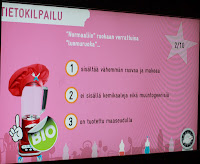The photos are of a computer screen which was part of a quiz for children on food. They're in Finnish but I'll provide the translation. Here's the question:
Knowledge Quiz:
Compared to "normal food", "natural food" ...
- Contains less fat and sweeteners
- Contains no chemicals and genetic manipulations
- Is produced in the countryside
And the answer is....
Natural food contains...no chemicals.
The next question should be then what is it made of? Pure energy? Some exotic matter? Maybe that's where all the dark matter in the Universe is....natural food.
The UK's Royal Society of Chemistry is offering a £1000000 (UK pounds) prize for anyone who creates a "chemical free" material. I guess no-one at that particular science museum has claimed the prize, which basically means they're either lying or stupid.
Here's a quote from the RSC:
Dr Neville Reed, a director of the RSC, said today: "I'd be happy to give a million pounds to the first member of the public who could place in my hands any material I consider 100% chemical free.
"Should anyone do this, we will see thousands of years' worth of knowledge evaporate before our eyes. We would have to tear up the textbooks, burn the degree certificates and retrain the teachers."
One of the major constituents of any food-stuff is water...you know that chemical H2O, sometimes known as dihydrogen monoxide...not to mention those other nasty chemicals such as sodium chloride, or L-ascorbic acid, or any of the myriad of carbon based chemicals...
Some might say that this only applies to "man-made" or "bad chemicals"...so what constitutes a "bad chemical" or even a "natural chemical"...well, plenty of interesting poisons exist in nature including cyanides and many, many radioactive materials too, so that can't be the definition.
Dihydrogen monoxide incidentally was the subject of many hoaxes based on a complete misunderstanding of what chemistry, chemicals and a basic knowledge of science.
I remember an advert on TV for some cosmetic product which contained only natural chemicals which must be "good"...natural chemicals such as I've already stated...such as cyanides naturally found in almonds and apple seeds.
So, anyone who states that something is "chemical free" is stupid, deranged and plain wrong. In fact, anyone who states such a thing in a science context should be...I'll let you decide on a suitable punishment...maybe something nasty such as not allowing them access to that most evil of bad chemicals: dihydrogen monoxide. This kind of crap has no place in a science exhibit, in childrens' education or in society in general - only bad things will come of this if this kind of nonsense is let to continue.
ps: I did ask a member of staff at the science museum about this - she had no answer other than it must be true otherwise they wouldn't have had such an exhibit...oh dear...



No comments:
Post a Comment